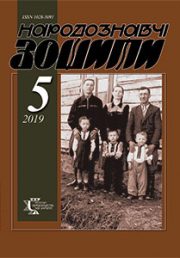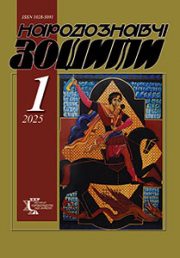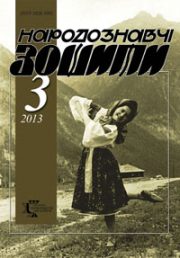The Ethnology Notebooks. 2018, 6 (144), 1596–1602
UDK 7:2.7.01/.03.726.477
DOI https://doi.org/10.15407/nz2018.06.1596
Received 21.11.2018
ORCID ID: https://orcid.org/0000-0002-8383-227X
Herii Oksana, Candidate of Sciences in Art Studies,
Senior Researcher,
Folk Art Department,
The Institute of Ethnology of the National Academy of Sciences of Ukraine.
15 Svobody Avenue, 79000, Lviv, Ukraine.
Contacts: Tel.: (032)297-01-57; e-mail: oheriy@ukr.net
Abstract. Artistic and stylistic features of the exterior of the group of churches in Galicia, built in the late nineteenth and early twentieth centuries, with original decorative elements — the angular pillars of the piles, are considered in the article. The specifics of the distribution and use of the Neo-Byzantine style in the art of Europe in the middle of the nineteenth century is characterized. The artwork of the Austrian architect Teophil Hansen and its significance in the development of the sacred architecture of Ukrainians are analyzed.
Keywords: Neo-Byzantine style, Hansen Teofil, Vasyl Nahornyi, Sylvester Havryshkevych, House of Disabled Veterans in Lviv.
REFERENCES
Bobosh, H. (2000). Halyts’ki murovani trybanni tserkvy kintsia XIX — pochatku XX st. Visnyk NU «L’vivs’ka politekhnika», 410, 219—222 [in Ukrainian].
Bobosh, H. (2000). Stezhkamy zhyttia ta tvorchosti Vasylia Nahirnoho (1848—1921). The Ethnology Notebooks, 2, 347—355 [in Ukrainian].
Kislyh, T. (2013). Vizantijskij stil’ v arhitekture stran Evropy konca XIX — nachala XX veka. In Problemy stilevoj evoljucii i tipologii arhitektury (pp. 71—79). Sankt Peterburg: IZhSA im. I.E. Repina[in Russian].
Kishkinova, E. (2014). Metamorfozy Vizantijskoj paradigmy: Vizantijskij stil’ v arhitekture zapadnoj Evropy konca XIX — pervoj treti XX veka. Sovremennaja nauka: Aktual’nye problemy teorii i praktiki, 7—8, 21—35 [in Russian].
Kishkinova, E. (2016). Stilevaja transformacija arhitektury vizantinirujushhih hramov Rumynii: dialektika nacional’nogo i nadnacional’nogo. Nauchnyj zhurnal Kubanskogo GAU, 123 (9), 1—12 [in Russian].
Linda, S. (2008). Arkhitektura. In Yu. Biriul’ov (Ed.), Arkhitektura L’vova: Chas i styli. XIII—XXI st. (pp. 308—309, 326—327). L’viv: Tsentr Evropy [in Ukrainian].
Nahirnyj, V. (1935). Z moikh spomyniv. L’viv: nakl. Revizijnoho Soiuza Ukrains’kykh kooperatyv [in Ukrainian].
Nahirnyj, V. (1905). Kil’ka sliv v spravi budivel’ tserkovnykh. Dilo, 225, 1, 5 [in Ukrainian].
Rakochyj, Ya., & Borys, A. (2015). Ontolohiia tvorennia ukrains’kykh natsional’nykh atrybutiv u sakral’nij arkhitekturi Halychyny. Visnyk NU «L’vivs’ka politekhnika», 836, 247—254 [in Ukrainian].
Savel’ev, Yu. (2014). Neovizantyjskije motivy v arkhitekture Frantsii. Academia. Arkhitektura i stroitel’stvo, 2, 25—34 [in Russian].
Slobodian, V., Lev, Kh., & Filevych, N. (2013). 100 tserkov Nahirnykh: Tserkvy l’vivs’koho arkhitektora Vasylia Nahirnoho. L’viv [in Ukrainian].
Slobodian, V. (1998). Tserkvy Ukrainy: Peremys’ka ieparkhiia. L’viv: Naukove t‑vo im. T. Shevchenka [in Ukrainian].
Slobodianiuk, M. & Nahirniak, M. (2008). Dim vijs’kovykh invalidiv. In A. Kozyts’kyj (Ed.), Entsyklopediia L’vova (Vol. 2, pp. 95—96). L’viv: Litopys [in Ukrainian].
Bullen, J.B. (2003). Byzantium Rediscovered. London: Phaidon Press Ltd.
Haus, A. (2005). Schinkel Karl Friedrich. In Neue Deutsche Biographie (Vol. 22, pp. 795—798). Berlin: Duncker & Humblot.
Krasny, Р. (2004). Kaplica Domu Inwalidуw Wojskowych. Koscioly i klasztory rzymskokatolickie dawnego wojewodstwa Ruskiego, 12, 67—76 [in Polish].
Purchla, J. (1997). Architektura Lwowa i Krakowa a Wiedeс. Zeszyty Naukowe Uniwersytetu Jagielloсskiego, 645: Prace Historyczne, 121, 354—355 [in Polish].






